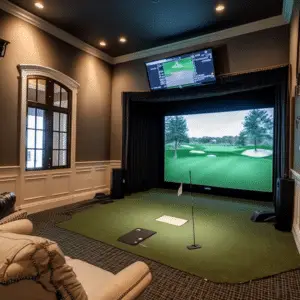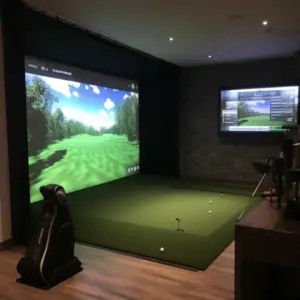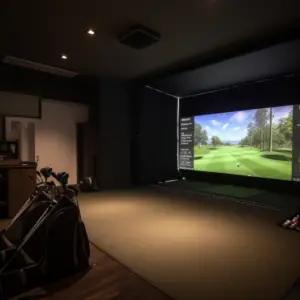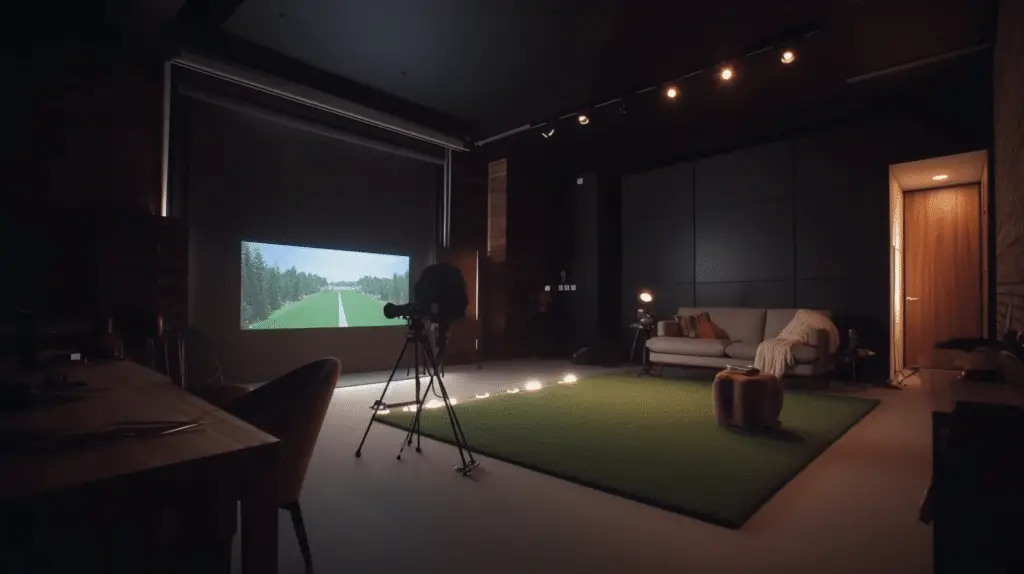Last Updated on October 16, 2023
Golf has become an increasingly popular sport that is enjoyed by people of all ages and abilities. With the ever-growing popularity, there is a need for more ways to hone one’s skills outside of traditional golf courses, like a golf simulator. But how much space do you need for a golf simulator? Let’s find out.
Minimum Room Requirements
The size requirements for a golf simulator are dependent on the type of system being used. Generally, an indoor golf simulator requires a minimum room width and depth of approximately 12 feet by 12 feet to ensure proper swing space. The height of the ceiling should be at least 8 feet from the floor level up in order to accommodate the location of the projector and sensor array.
Additionally, there must be adequate clearance around all sides for full arm extension during swings. Furthermore, most systems also require a solid wall or curtain behind you as well as both sides that can absorb sound; this helps reduce any interference with ball tracking accuracy. This will help achieve realistic launch conditions within the simulation environment. A separate larger area is needed if netting is desired in order to protect surrounding areas from errant shots.
Best Room Size For Optimal Performance
The size of the room needed to install a golf simulator will vary depending on the type and brand being used. However, for optimal performance and accuracy in golf simulation performance, it is recommended that an area measuring at least 10’ x 12’ be available. This space should provide enough clearance from all sides so that the projector or television screen can project correctly onto the hitting surface without obstruction. In addition, it may also be necessary to account for extra space if other components, such as furniture or additional equipment, are required.
It should also be noted that certain simulators are designed with specific room dimensions in mind. Therefore, it is important to select one whose layout matches the room size available. For example, some models require 14′ x 16′, while others may need up to 24′ x 28′. By researching each model’s specifications prior to purchase, users can ensure they have chosen a system which offers maximum compatibility with their home setup. Ultimately this will lead to improved golf simulator performance and a more realistic virtual golfing experience.
Setup Considerations

One of the most important factors when planning out a simulator setup is determining how much room space would be necessary for effective use. This primarily depends on what type of projector or display system will be used as well as if any additional equipment such as cameras, sensors or tracking systems are required. Generally speaking, having at least 8-10 feet horizontally and 6-8 feet vertically available should provide enough clearance to install these components while allowing comfortable playability. Additionally, some extra floor area may need to be cleared depending on the size of the matting being used and which club(s) you plan on using during your simulation sessions.
Overall, understanding the amount of space needed, along with other important considerations, can help create an enjoyable and productive golf simulator setup suitable for virtually any skill level. By taking time to research installation requirements prior to setting up a new system, users can ensure they have everything they need before beginning their virtual golf journey.
Projector Placement
When it comes to projector placement for a golf simulator, there are several factors to consider. The most important factor is the size of the projected image and how much space is needed in order to achieve an optimal projection experience. Depending on the room size and type of projector used, different approaches may be necessary when positioning the projector. For example, if a small area needs to be covered with a low-end projector, then its throw distance should remain relatively close, whereas a more powerful model can cover larger areas from further away. Additionally, the orientation of the projector must also be taken into account, as some models only produce images that are rotated 90 degrees or more when mounted upside down.
To ensure proper coverage and minimize distortion caused by incorrect angles or distances, it is best practice to use specialized mounts designed specifically for projectors so they can be placed in their ideal positions within any given room. This will help create an immersive environment for users while giving them even coverage across all sections of the simulator’s virtual course. Furthermore, depending on budget constraints and available resources, one could opt for automated mounting solutions, which allow easy adjustment at predetermined intervals without manual intervention.
Impact Screen Installation

When installing an impact screen for a golf simulator, it is important to take into account the size of the space available. The width and height of the wall will determine how much room is needed for installation. An adequate amount of space must be allocated in order to ensure that there is enough clearance between the walls or other structures and the impact screen.
The following tasks should be completed when setting up an impact screen:
- Measure the dimensions of the space where you intend to install your impact screen;
- Purchase a Golf Simulator Impact Screen that fits within those dimensions;
- Set up any support poles necessary for installation;
- Assemble and affix all components properly.
It is also advised to use professional assistance with golf simulator installation since this type of setup involves multiple components which require specific alignment and placement in order to work effectively. Professional technicians are trained to ensure proper alignment and assembly so as to avoid potential damage due to incorrect installation. This helps guarantee an enjoyable experience while using a golf simulator, with minimal disruption from technical issues caused by improper setup.
Accurate Measurement Technologies
Accurate measurement technologies are essential for an effective golf simulator. A swing analyzer is necessary to accurately measure the speed, direction, and spin of a golfer’s swing. Additionally, ball tracking technology must be used to provide accurate data about the trajectory of a hit ball. This information can then be used by simulator software to simulate the effects that physical factors such as weather and terrain have on the flight path of a ball in real-world situations.
Appropriate space needs to be provided to ensure accuracy with this equipment; typically, at least 10 feet (3m) from the back wall to the front wall and 10 feet (3m) from left-right side walls are recommended for full swings with drivers or long irons. The area should also remain free of obstructions like furniture or hanging objects since any interference could cause inaccurate results. With these measurements taken into consideration, golfers will gain more confidence in their skills and improve their game.
Frequently Asked Questions
What Type Of Golf Simulator Should I Buy?
When it comes to buying a golf simulator, there are several types available on the market. From low-cost entry level simulators to commercial-grade systems, buyers have a number of options when considering what type of simulator is best for their needs. A comprehensive golf simulator buying guide can help narrow down the selection and provide advice on features and costs associated with each model.

Indoor golf simulators are becoming increasingly popular due to their convenience, affordability, and wide range of applications. With many models offering advanced graphics, realistic feedback, and accurate swing analysis software, these devices allow users to practice their game indoors without having access to an outdoor course or driving range. Furthermore, they can be used in conjunction with virtual reality (VR) technology for an even more immersive experience while playing golf online against other players around the world. Ultimately, choosing between different golf simulator types will depend on the specific requirements of each buyer as well as budget considerations.
Given all these factors into account, prospective buyers should consult a golf simulator buying guide that outlines the key differences between various models so they can make an informed decision about which one is right for them. It’s also important to consider whether additional accessories, such as impact screens, are necessary based on where you plan to set up your indoor golf simulator setup. Taking time to research all of these aspects ahead of making a purchase will ensure maximum satisfaction once installation has been completed.
What Is The Cost Of A Golf Simulator?
The cost of golf simulators can vary greatly depending on the type and features desired. The price of a basic simulator may range from several hundred dollars, while more sophisticated ones with additional amenities could be thousands of dollars. When buying a golf simulator, it is important to consider what kind and brand one wants, as well as any available options in terms of extra technology or accessories that might come with it.
For instance, some golf simulators are made for commercial use and thus will likely have higher costs associated with them due to their size and complexity. Others may offer more interactive features like motion sensors or 3D tracking capabilities, which add to the total cost. Additionally, factors such as installation requirements should also be taken into account when estimating the overall cost of purchasing a golf simulator.
It is essential to do research before selecting the right golf simulator for your needs and budget. By understanding all potential costs involved in buying a golf simulator—including setup fees, monthly subscription fees (if applicable), and shipping charges (if purchasing online) —one can make an informed decision about which option best suits their individual preferences and circumstances.
Conclusion
The decision to purchase a golf simulator should be based on the available space, budget and level of expertise. The type of golf simulator purchased will depend on how much space is available and how often it will be used. It is also important to consider the cost of purchasing a golf simulator as well as the time required for installation and maintenance.
In terms of suitable spaces, there are several options, including an indoor or outdoor area, garage, basement or even a dedicated room in the house. Indoor golf simulators require more setup than outdoor ones but offer greater accuracy due to better lighting conditions. Outdoor simulators may not have the same precision but can still provide an enjoyable experience depending on weather conditions.
When considering all these factors before buying a golf simulator, potential buyers should take into account their individual needs and preferences before making any decisions. A good quality system with proper maintenance can last up to 10 years, so investing in one could turn out to be a long-term investment that offers many hours of enjoyment both indoors and outdoors.


